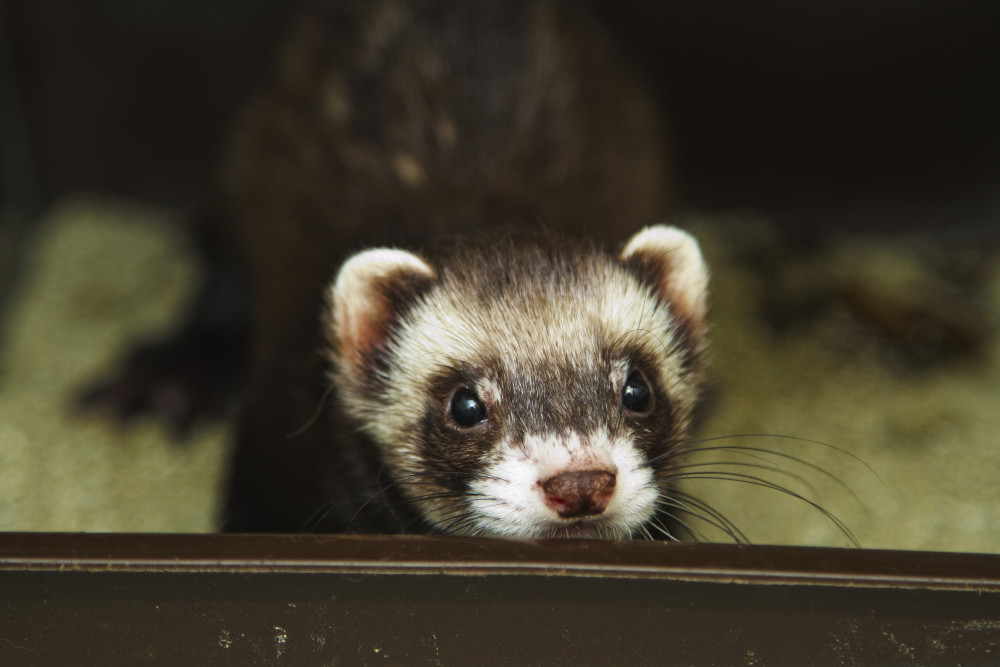How do I litter train my ferret?

Cleaning up after ferrets who have been to the toilet is not necessarily one of the most fun things about owning them – but it’s very important! The good news is your ferrets are smart, and they’ll quickly and easily learn to use a litter box with a little bit of training. Keep reading for what you need to know to litter train your ferret (plus what to do when they have an accident).
What sort of litter tray and litter should I use?
The basic requirements for litter trays (also called litter boxes) for ferrets are that they are:
- Shallow (no greater than 10cm in height so it is easy for your ferret to get in and out of) and large enough for all four of your ferret’s feet to fit inside and for them to be able turn around in it comfortably. Try to get a litter tray specifically made for ferrets since ones that are made for larger animals might be too tall for your ferret to get inside.
- You can get standard tray litter trays or get a corner litter tray that easily tucks into the corner of a room or enclosure.
- Half-fill the litter tray (a minimum of 5cm deep) with dust-free, unscented substrate (e.g., recycled paper pellets or compressed wood pellets). Avoid any clay or clumping cat litter since they’re too dusty and could damage your ferret’s respiratory system. Cedar and pine shavings can also irritate your furry friend’s nose and lungs, so steer clear of them as well.
You can also line around the outside of the litter box with puppy pads to prevent messes if your ferret likes to dig in their tray.
Where should I put the litter tray?
Place a shallow litter tray in the corner of your ferret’s enclosure. (Put food and bedding in the other corners of the enclosure – like a lot of animals, they don’t like going to the toilet where they eat and sleep.)
If your ferrets come out of their enclosure, keep a litter tray in every room where you let your ferret out so they’re never far if they need to go. If they choose certain spots in their enclosure or a room as their preferred toileting area (even if there isn’t a try there), you might like to reposition the trays into those areas. That way they are more likely to use the litter tray as it is where they feel safe.
When are they most likely to want to go to the toilet?
Ferrets have a short digestive system – so food goes through them quickly, and they need to toilet frequently throughout the day. They usually toilet within 15 minutes of waking up from a nap or eating a meal, at the beginning or end of times of activity, after eating, and roughly every 3-4 hours.
Their normal behaviour is to back up into a corner until their back end is touching the wall; they then lift their tail and squirt their naturally quite loose faeces upwards. Note that it is normal for ferrets not to bury their faeces and to perform an ‘anal drag’ to scent mark after they toilet which usually results in another smaller deposit of faeces a little away from the main deposit.
How do I teach my ferret to use the litter tray?
If you’re worried about your ferret having an accident while outside their enclosure, limit their time outside it to 1–2 hours. You can also try some of these training tips:
- Place some of your ferret’s droppings inside the litter tray. The scent of your ferret’s droppings will remind them to visit their litter tray any time they need to go.
- Start off by putting your ferret in their litter tray as soon as they wake up or eat. Don’t let them out of their enclosure to play right away. After they use the tray in the enclosure, you can let them out as long as you supervise them.
- Use positive reinforcement with your ferrets by stroking and praising them once they go, even giving them a tasty treat as a reward. This way they will associate using the litter tray with getting a reward. As long as you continue rewarding your ferret, they will learn to go in the litter tray faster. (Note though, that some ferrets may pretend to be toileting, just to get a treat. Make sure your ferret has actually done their business before rewarding them!)
- Keep track of the time since your ferret last went in their litter tray and supervise them when you’re letting them out of the enclosure. Lead your ferrets to their litter every 3–4 hours or, if they start backing up towards a corner of the room, move them to a litter tray instead.
As long as you reward your ferrets each time they use their litter tray, it should only take about a week to train them. Once they start using their tray consistently, let them roam around outside their enclosure with an extra litter tray in the corner of the room. Supervise your ferret and guide them to the new tray if they ever need to go (you’ll know when – they start to back up into a corner).
Ferrets are bound to have accidents when you first start training them. Never punish or scold your ferret since they might become afraid of you. Just clean any accidents outside the tray with a ferret safe enzymatic cleaner to remove any odours that might bring them back to the same place (talk to your veterinarian for advice on products that are safe for ferrets). You can scoop up any accidents and place them in the litter tray. When your ferret picks up the scent, they’re more likely to toilet there.
Your ferret may stop using their litter tray if it gets too full. Check the tray every day and use a litter scoop to pick up any waste. Just be sure to leave some droppings in the litter tray to keep your furry friend from digging or playing in it. The litter tray should be washed with hot water and unscented soap and the litter changed completely every 2 days (or every day if you have multiple ferrets using the same litter tray).
Bibliography
Meredith A (2016) Ferret behaviour, housing and husbandry. In: Johnson-Delaney C (ed) Ferret Medicine and Surgery. CRC Press, pp 31–46
Vinke C, Schoemaker N, van Zeeland Y (2021) Behavioural biology of ferrets. Behavioural biology of laboratory animals
Was this article helpful?
This work is licensed under a Creative Commons Attribution-NonCommercial-NoDerivatives 4.0 International License.



